Understanding Ball Valve Seat Fundamentals
Ball valves are critical fluid control devices designed to open or close fluid passages within pipelines. Their core function relies on a rotating ball with a bore. Torque applied via the stem (typically a 90-degree turn) drives this rotation to achieve flow or shutoff. The sealing performance, however, is fundamentally determined by the design of the valve seat.

Seat designs primarily fall into two categories based on ball movement:
1. Fixed Seat with Floating Ball: Fluid pressure displaces the ball downstream, forcing it tightly against the downstream seat, creating a single-direction seal.
2. Floating Seat with Fixed Ball: The ball remains stationary. Sealing pressure is generated by springs or fluid pressure pushing the seat(s) against the ball to establish the required sealing specific pressure.
Soft Seat Ball Valve Seats
Soft seats utilize elastomeric or polymeric materials for tight sealing, offering excellent shutoff but with temperature/pressure limitations compared to metal.
1. Standard Type
Standard soft seats (Fig 1) achieve sealing through the elastoplastic deformation of the seat material when compressed against the ball by preload or fluid pressure. Effective sealing depends on the seat material’s ability to compensate for the ball’s roundness deviations and surface micro-irregularities under pressure. Maintaining sufficient sealing specific pressure between seat and ball is paramount.
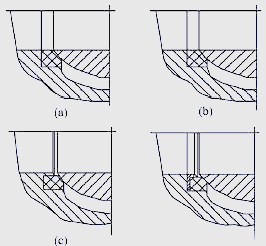
2. Elastic Type
Elastic seats (Fig 2) incorporate flexible elements like metal spring cages or coil springs. These elements allow the seat to deform elastically under preload or fluid pressure. This design effectively compensates for impacts on sealing caused by temperature fluctuations, pressure changes, and wear.
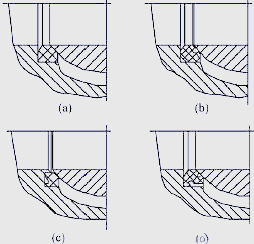
(a) Single Bevel Type
(b) Double Bevel Dual-Line Type
(c) V-Line Self-Sealing Type
(d) Special Type
3. Spring-Assembled Type
The core principle (Fig 3) involves uniformly distributing a set of compression springs around the valve channel’s circumference, or using a single disc spring. This arrangement provides continuous thrust, ensuring the seat maintains constant pressure against the ball for a reliable preload seal.
(a) Compression Spring Type
(b) Disc Spring Type
4. Piston-Type Seat
Piston seats (Fig 4) utilize inlet medium pressure to generate the sealing force. This pressure pushes the piston-like seat against the ball, causing elastoplastic deformation in the sealing ring to achieve tight closure.
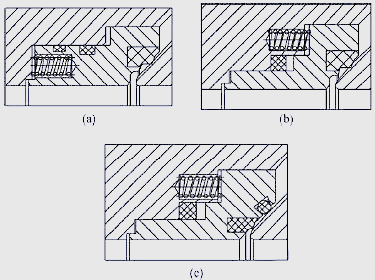
(a) Block & Bleed Seat (Double Block and Bleed – DBB): Features a unique safety design. If cavity pressure exceeds downstream pressure, an outward force overcomes spring resistance, separating the seat from the ball. This allows overpressure in the cavity to vent downstream. Springs then re-seat the valve upon pressure equalization.
(b) Double Movement Seat: Activates when cavity pressure surpasses outlet pressure. The seat’s compressive force causes elastoplastic deformation in the seal ring. This design offers automatic compensation; if the upstream seal fails, the downstream seat immediately engages.
(c) Dual-Stage Sealing Seat: Engineered for high sealing loads. Combines rubber (primary sealing) and plastic (support and secondary sealing) in a composite structure for enhanced reliability and longevity.
5. Special Structure Seats
This category encompasses various unique designs tailored for specific needs and conditions:
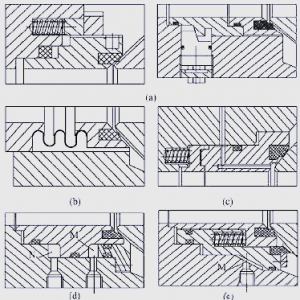
(a) Internally/Externally Adjustable Seat
(b) Bellows Seat
(c) Grease Injection Seat
(d) Double-Acting Seat
(e) Combination Seat
• Internally Adjustable Seat: Uses an internal adjustment nut to regulate sealing specific pressure between seat and ball, offering the advantage of no external leakage points.
• Externally Adjustable Seat: Employs an external screw plug to press a wedge, displacing a telescoping sleeve to adjust the seat-to-ball sealing specific pressure.
• Bellows Seat: Typically welded (electron beam or TIG) to the seat and guide sleeve. Design must ensure the seat sealing center is smaller than the bellows mean diameter. Provides reliable sealing, large elastic compensation range, and 3D flexibility.
• Grease Injection Seat: Aims to enhance sealing, reduce friction/wear, extend service life, and prevent seat failure/fire incidents. Features grease injection ports. Note: Grease injection is primarily auxiliary and not universally applicable.
Double-Acting Seat: When chamber ‘N’ receives control pressure, the seat presses against the ball for sealing. When chamber ‘M’ receives pressure and ‘N’ vents, the seat retracts, minimizing contact, wear, friction, and operating torque. Ideal for high/medium-pressure, large-diameter ball valves.
• Combination Seat: Integrates a spring-assembled seat (primary seal) with a piston-type seat (which provides auxiliary sealing when control pressure is applied).
Metal Seat Ball Valve Seats
Metal Seal Ball Valve seats use metal or composite materials for superior temperature, pressure, abrasion, and corrosion resistance, often with higher leakage rates than soft seals but essential for severe service.
1. Base Metal Seat
Manufactured by depositing a layer of hard alloy (e.g., Stellite, Tungsten Carbide) onto a metal substrate via welding (Fig 6). Incorporates an elastic tail seat to significantly reduce friction and damage on the sealing faces during operation.
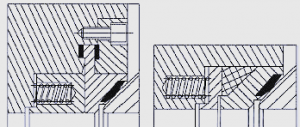
2. Multi-Layer Seal Seat
Constructed by alternately layering multiple stainless steel sheets and thin graphite sheets, then roll-compacting them under special processing (Fig 7). This unique structure delivers exceptional performance under high temperatures and pressures.
3. Hollow Tube Seal Seat
Features inner and outer bushings with a stainless steel tube core (Fig 8). Sealing relies on the elastic force generated by the hollow tube deformation to press the seat tightly against the ball.
4. Rotating Seat
A unique design (Fig 9) where the seat rotates around the channel axis during valve operation. Teeth uniformly spaced around the seat circumference cause the seat to incrementally rotate (by one tooth) each time the ball closes. This ensures even circumferential wear, optimizing performance and extending service life.
Critical Valve Seat Materials
Special Polymer Materials
Offer excellent sealing, low friction, and chemical resistance within defined temperature/pressure limits.
• PTFE (Polytetrafluoroethylene – F4): Renowned for exceptional heat/cold resistance (-250°C to +260°C), non-stick properties, low friction (μ~0.05), and chemical inertness (resists strong acids, alkalis, oxidizers). Handles ~5MPa load.
• PCTFE (Polychlorotrifluoroethylene – F3): Offers high strength, hardness, dimensional stability, no cold flow. Temperature range: -195°C to +120°C. Resistant to hot inorganic acids, cold salt solutions/oxidizers, and most organics at RT.
• FEP (Perfluoro(ethylenepropylene) – F46): Combines wide temp range (-85°C to +205°C) with PTFE-like chemical stability (resists acids, alkalis, alcohols, ketones). Moderate density, thermal conductivity, and expansion.
• Polyamide (Nylon 1010 – N1010): High tensile strength, impact toughness, abrasion resistance, and self-lubrication at RT. Low friction (μ~0.03), density ~1.5g/cm³. Resists weak acids/alkalis, general solvents, and oils.
• PPL (Para Poly Phenylene): Excels in high-temp resistance, chemical corrosion resistance, self-lubrication. Density ~2g/cm³, expansion ~5.1×10⁻⁵/°C, hardness ~80HS. Resists sulfuric acid, HF, strong alkalis. Excellent radiation resistance, friction μ~0.13.
• PEEK (Polyetheretherketone): Blends thermoset-like heat/chem stability with thermoplastic processability. Continuous use >240°C (up to >300°C glass-filled). Resists most inorganic solvents and long-term steam exposure (200-260°C).
• PI (Polyimide): Advanced high-temp plastic for long-term air use (-240°C to +260°C). Excellent electrical insulation, wear resistance, radiation resistance, and mechanical properties. Resists dilute acids/organic solvents at RT. Avoid strong oxidizers/acids and prolonged water immersion.
Metal Seal Materials
Chosen for extreme conditions: high hardness, suitable hardness differentials between faces, enhanced wear resistance via surface hardening.
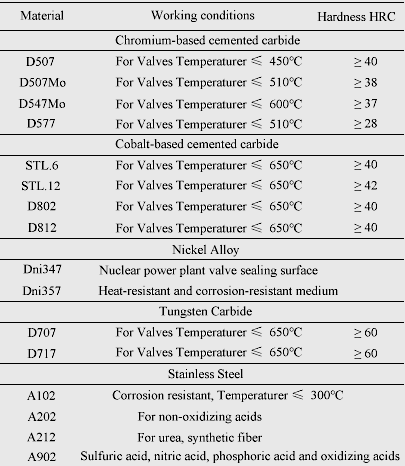
• Chromium-Based Hard Alloys (e.g., Stellite)
• Cobalt-Based Hard Alloys (e.g., Tribaloy)
• Nickel Alloys (e.g., Inconel, Hastelloy)
• Tungsten Carbide (WC)
• Stainless Steels (e.g., 316, 17-4PH, 440C – often hardened) (See Table 1 for comparison)
Conclusion: Key Takeaways on Ball Valve Seats & Seals
• Seal Ring: Must exhibit high stability, low friction coefficient, excellent aging resistance, and outstanding sealing performance.
• Valve Seat: Requires sufficient strength and rigidity. Clearance design is critical to maintain shape under pressure. Must resist deformation.
• Metal Seats: Must deliver exceptional performance across extreme environments: high temperature, high pressure, strong corrosion, cryogenic conditions. Critical requirements include near-zero leakage, long service life, fire safety certification (API 607/6FA), and outstanding pressure/abrasion resistance.
Explore Premium Ball Valve Solutions Engineered for Your Toughest Applications.
Post time: Jul-12-2025






